18
Bar-Hopping, International Style
The Best and Most Storied Beer Bars Across the Globe
America has some truly iconic drinking establishments, but those are only a fraction of what the entire planet has to offer.
Toronto, Ontario, Canada
It’s no surprise that Canada’s largest, most cosmopolitan city has a fairly hopping (pun intended) craft beer scene. Mention beer to a local and the first response you’re likely to get is, “Have you been to Bar Volo?” The venue became a fixture of central Toronto’s Yonge Street in 1985, when it opened as an Italian restaurant. Talk about knowing how to evolve with a changing market: It eventually morphed into one of the most respected craft beer establishments throughout Canada, as well as a good place to eat, with lots of Southern Italian and Spanish-inspired small plates (mostly locally sourced), which go great with the more than fifty bottles of beer and cider, twenty-six taps, and six cask-conditioned offerings. Bar Volo was also home to House Ales project, its own small pilot brewery in its kitchen making English, American, and Belgian-style beers, often collaborating with some of Canada’s finest production breweries. Dangling vines beckoned drinkers into the charming brick building, and rows of bottles serve as the primary décor inside; evening candlelight gives them an ethereal glow. If this is reading more as a eulogy than an endorsement, that’s because in 2016 its landlord informed the Morana family, owners of the Yonge Street institution, that they would have to vacate the site by fall to make room for condos—sadly, an all-too-familiar scenario.
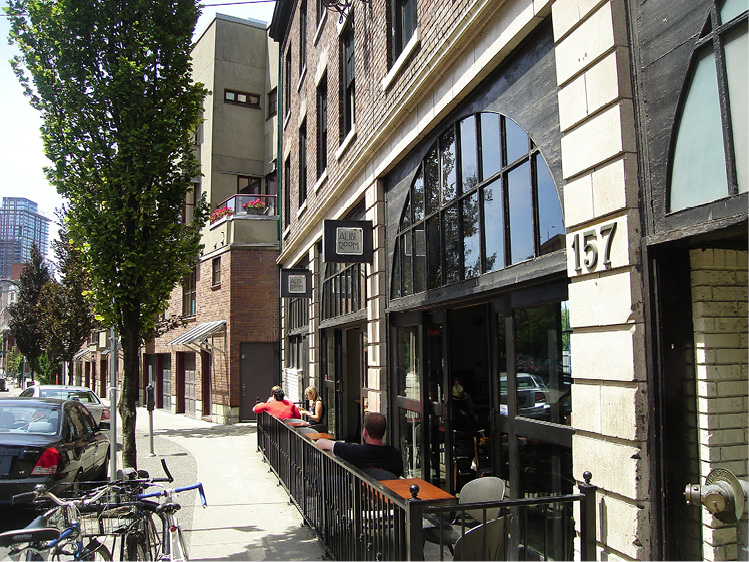
Vancouver’s popular beer gastropub, Alibi Room.
Vancouver, British Columbia, Canada
It’s almost comical that one of Western Canada’s best craft beer bars has the same name as the filthy den of liver-obliteration/sometime brothel on the Showtime series Shameless. But the Alibi Room in Vancouver couldn’t be in starker contrast with the fictional Chicago dive. (To be fair, there are plenty of bars that have adopted the moniker.) The Vancouver spot is a sprawling two-story affair in a historical brick building constructed at the turn of the twentieth century along the side of the city’s railyard—constructed for easy access to the city’s still operational shipping port. Its twenty-first-century iteration is the center of British Columbian craft culture, and it has fifty taps (with flights of four tasters available) that heavily emphasize locals and regionals (the cask-conditioned offerings are almost always local). The food boasts equally artisanal and ethical origins, with locally sourced, free-range, naturally raised and/or ocean-friendly meats, fish, and vegetables. Those feeling sociable can sit at the long communal tables, but there are plenty of private spots to keep things intimate. The ample natural light makes it an ideal spot for day drinking—especially if you don’t want to forget that it’s the middle of the day—and for a hair-of-the-dog brunch. Tabletop candles set the mood after dark.
London, England
There’s likely no better physical representation of the craft-inspired shift that’s taking place in the United Kingdom than Euston Tap, which is located inside a small stone Victorian building that once served as a gatehouse near intercity railway terminus Euston Station. And it’s also the perfect example of how to honor tradition while diving headlong into the future.
Like any good London pub, it has a healthy array of real ales on cask—eight at any given time and always rotating—nineteen standard draft lines, and 150 bottles. Up until recently, such numbers were unheard of in Britain, mainly due to the fact that brewers also control chains of pubs. Euston Tap is completely independent of that sort of arrangement. What’s also unheard of is the fact that a pub near a train station has such a robust collection of drinking options.
The selection gives a nod to legends of the US craft-brewing scene, with some selections from other countries (Belgium among them, of course) as well. But you’ll also get a showcase of the new wave of British brewers that are shaking up the country’s centuries-old traditions. The street-level bar area with limited seating is fairly tight and gets crowded very quickly. (It almost seems like a dimension-defying feat getting all those brews in there.) There some more seating upstairs and a heated beer garden just outside so folks needn’t feel like sardines.
Inverness, Scotland
In the northern Scottish Highlands, near the notorious Loch Ness, lies the great city of Inverness, which is just as famous for its legendary golf course as it is for the aquatic monster a handful of miles away. The best place to sample the pales, porters, IPAs, stouts, and lagers (on cask and in bottles) of one of the leaders of the new wave of Scottish craft brewers—nearby Black Isle Brewery—is at the festively named Hootananny. It didn’t earn the moniker because of its raucous clientele—they tend to be much more laid back than that—but from the fact that it doubles as a live music venue. It’s the best place to discover the up-and-coming acts of northern Scotland and beyond. On many nights, there are classic Celtic folk combos performing at a center table, allowing visitors to fully absorb the full Scottish experience.
Dublin, Ireland
For the longest time, Dublin has been a one-beer town. To be sure, Guinness is still ubiquitous and impossible to avoid when you’re in the country, let alone the city in which it’s brewed. But Irish pubs are getting more generous with their taps, as the global craft beer wave sweeps through the Emerald Isle. One of the best selections you’ll find in the capital city is at Against the Grain. What it lacks in name originality, it more than makes up for in variety. It’s owned by Galway Bay Brewery, which cranks out some favorable porters, IPAs, Irish reds, and, of course, stouts. But there’s plenty more to discover at Against the Grain from breweries inside and outside the country. It’s the best miscrocosmic snapshot a drinker can get of the grander Irish craft beer scene. There’s plenty of space to spread out—lots of nooks and crannies, booths, and drinking ledges—and a tasty pub menu (burger meats include lamb). Lots to explore as far as taps and bottles go, as well.
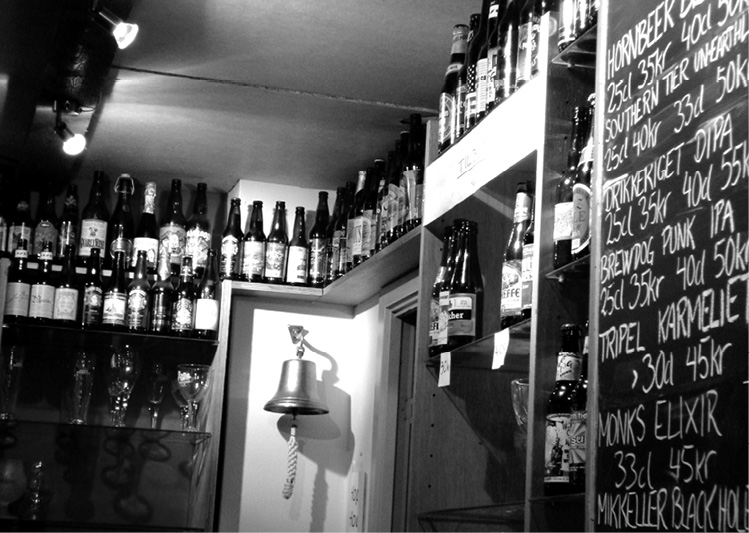
Copenhagen’s Øl Baren.
Copenhagen, Denmark
If you’re planning to visit Copenhagen, here are two pieces of advice: No. 1, consider winning the lottery or robbing a bank because everything there is ultra-expensive. It makes New York seem like a rural community in the heartland by comparison. No. 2, if you do go, you have to have a beer at Øl Baren (it’s probably all you’ll have money for anyway.) The space is fairly small, but the beer selection is far from it. Bottles from all over the beer-making planet line the top shelves behind the bar, creating a sort of beery little welcoming committee for all who enter. It’s a popular spot among local industry folk. Local brewery and bar staff (yes, even other beer bars) often end up, post-shift, at Øl Baren and usually close the place.
A somewhat larger affair is Ørsted Ølbar, which is a bit more date friendly, with its evening candlelight (with empty beer bottles as makeshift candle holders), exposed brick walls, rustic wooden tables, and loungey couches and armchairs. The twenty taps serve a fresh, rotating selection of international artisanal brews. But the place knows how to let its hair down—there’s a foosball table and plenty of European sporting events on the TV.
Stockholm, Sweden
For a sense of the beer scene in another Scandinavian country, Akkurat in Stockholm is a good place to start. The draft and bottle lists pull from the best brewing nations around the world and have a strong emphasis on Belgium. (Don’t worry; there’s plenty of Swedish stuff as well, including products from the Brooklyn Brewery/Carlsberg joint venture, Nya Carnegie Bryggeriet, and Skebo Bruksbryggeri.) Akkurat partners with the folks at the Belgian lambic brewery Cantillon, and there’s always a surprising number of fresh Cantillon products for a bar that’s not based anywhere near Brussels. A big chunk of the bottle list reads like a love letter to lambic and gueuze.
Tokyo, Japan
Japan’s been a hotbed of craft-brewing activity of late, and the most vivid representation of that is a bar called Popeye in the Ryogoku district. The pub offers more than seventy beers on tap and has an international selection, but a lot of its focus is on the stuff produced on Japanese soil. It’s a tough choice, so luckily you can order sampler trays to get a good cross-section of the local options.
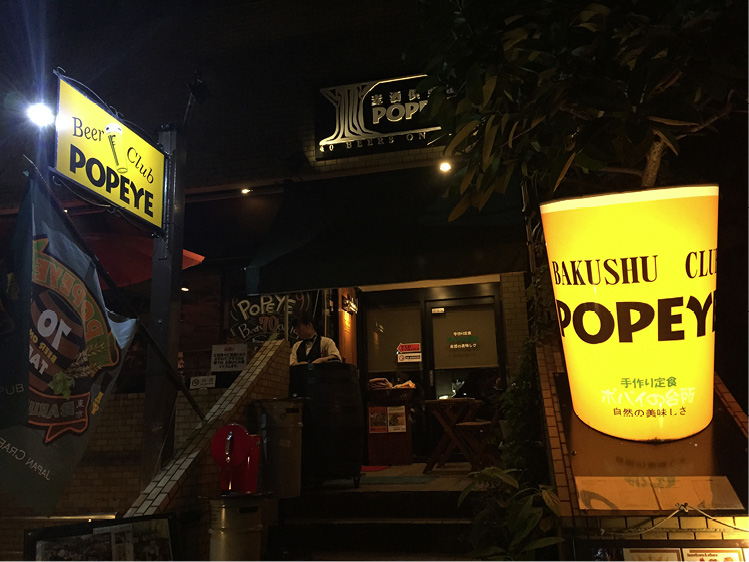
Popeye, perhaps the most famous beer bar in all of Japan.
It’s also one of the few spots throughout the country where you can drink without inhaling secondhand smoke. Yes, there’s still a robust indoor smoking culture in Japan, and it’s all still legal. You could be sitting at a sushi bar, enjoying the fresh Chu-toro, and you could be bookended by two human chimneys. At Popeye, there is an outdoor terrace where smoking is permitted. So if you’re a nonsmoker and the weather’s nice, it’s a bit of a tradeoff.
Inside, it gets noisy and crowded and the tables are very close together, but that’s not a bad thing if you’re in the mood. There’s no better way to absorb the energy of the Japanese beer scene.
Brussels, Belgium
One can’t speak about Brussels without mentioning three pubs in particular—two classics and one relative newcomer. Of the former sort, the one to which most folks passing through the Belgian capital often make a beeline is Delirium Cafe, if for no other reason than to experience a beer list whose extensiveness is nothing short of intimidating. In 2004, Delirium made the Guinness Book of World Records for being the brewery with the most varieties of beer commercially available, which, perhaps not so coincidentally, was tallied at 2,004. At last count, it offered somewhere in the neighborhood of 3,000 different bottles. If you’re lucky, you can get a peek inside the cellar in which they’re all kept in tip-top shape.
About a seven-minute walk from Delirium, across the city’s Grand Place, is another legendary Brussels staple, Poechenellekelder, which sits directly across from the famous Manneken Pis statue (the one of the boy urinating). There’s a nice cross-section of Belgian ales, offering a tour through the country’s wealth of styles. Aesthetically, the prime attractions of this two-story pub in the city’s cobblestone quarter are the marionettes dangling from the walls and rafters. There’s a romantic, medieval entertainment element to it, as well as a slightly creepy vibe.
The newer kid on the block, in the more modern part of the city, is Chez Moeder Lambic, which resembles more of a post-craft-beer-boom bar.
Brugge, Belgium
If Belgian beer is a religion, then ’t Brugs Beertje is its cathedral. (The name means “the Brugge/Bruges Little Bear.”) Metal signs from breweries from all over the country adorn the walls of its two rooms, and the list, which focuses only on styles of Belgian origin, features some three hundred bottles from across Wallonia and Flanders. Pilsner may be the most widely produced and consumed style in the country, but it’s not quintessentially Belgian. Founder/owner Daisy Claes is a legend on the international beer scene. The menu features some light bar bites—cheeses, pickles, and charcuterie mostly. Claes and her staff are visibly passionate about what they do and are always happy to offer a suggestion or, when they’re not slammed during peak times, just chat at length about beer. The bar is centrally located in Brugge’s fairy-tale-like medieval old town of cobblestones and canals.
While we’re in Brugge, we might as well stop in at La Trappiste, which has quite a robust list of Belgian ales, many of which you’re likely to find over at ’t Brugs Beertje. However, you don’t’ want to miss the chance to drink them in La Trappiste’s setting; the place is a cavernous, partially subterranean pub with an interior almost entirely composed of brick. The arched ceilings and low lighting make it as close to drinking in a medieval castle as you’re ever going to get.
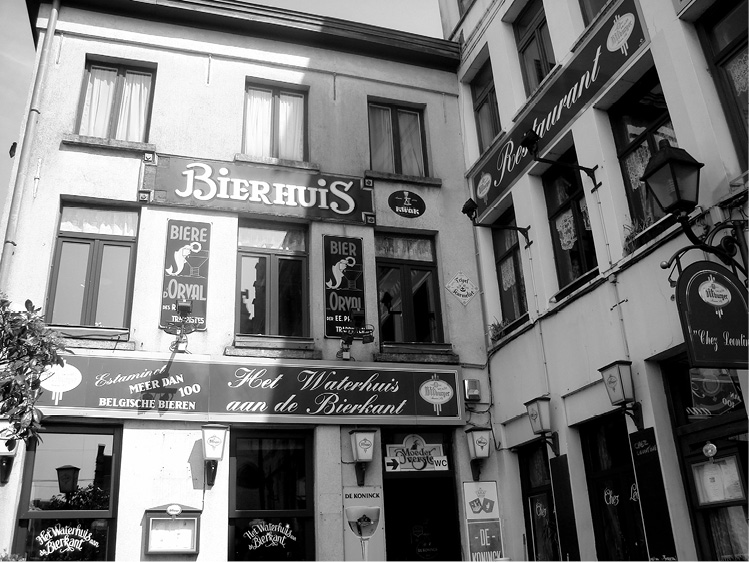
Het Waterhuis van de Bierkant sits on the edge of a canal in Ghent. Its name playfully translates to “Waterhouse on the Beerside.”
Ghent, Belgium
Since we’re already in the heart of Flanders, a quick jaunt to one of the region’s other great cities, Ghent, is an absolute must (it’s barely a thirty-minute train ride from Brugge). If there’s ever been a drinking establishment that is inextricably linked with the city, it’s Het Waterhuis aan de Bierkant, which translates to the rather playful moniker, “The Waterhouse on the Beerside.” It’s the owners’ way of saying, “It may seem like our pub is adjacent to a canal, but it is really the canal that is adjacent to our pub.” With close to two hundred of the best beers the smallish Western European country has to offer, it earns the right to have that name. Not to say the water is a mere supporting player. It’s just as much a reason to spend an afternoon there sipping Trappist ales and Flemish sours paired with local delicassies and cheeses. There are plenty of views from indoors, but there’s no comparison to sitting on a table on the patio, watching barges of sightseers drifting down the canal, and soaking in the Flemish architectural splendor of the waterside row houses and restaurants. Late spring and early autumn days are the best for that. It’s also spitting distance from one of Ghent’s biggest historical attractions, the medieval Gravensteen castle.
Sydney, Australia
Australia has had a bit of a craft brewing renaissance, not unlike America’s, though it occurred a good fifteen or so years behind it. Around 2013 boutique beer bars started popping up in earnest, thanks to a change in the law that made the licensing for such startup craft-friendly operations much more affordable. Previously, it was next to impossible to turn a profit if a bar wasn’t large and established and pushing high-volume macro-produced beer. Since the liberalization of such restrictions, local entrepreneurs wasted no time in fashioning a world-class beer bar scene. In Sydney’s Darlinghurst district is Bitter Phew, which opened in 2014 and is something of a microcosm of the country’s craft explosion. The upstairs climb reveals an airy, SoHo (New York) gallery-like space, complete with paintings and photos from local artists affixed to the walls. Bitter offers more than a phew selections. Twelve rapidly rotating taps and ninety-seven bottles put an emphasis on the global scale of the artisanal beer boom, with plenty of American, Belgian, and Scandinavian craft offerings to go around. The locals, of course, get their due with plenty of the draught lines dedicated to products from New South Wales and beyond. There’s a definite hipster slant, but that’s to be expected these days in craft beer bars. The music selections offer a little something for everyone, from big band to St. Vincent.
Keg & Brew (aka K&B), in the Surry Hills neighborhood offers an impressive cross-section of modern Australian craft beers as seen through the eyes of old Sydney. It was founded in 1936 and feels a bit like the love child of a traditional English pub and a rural American roadhouse. The walls are a shrine to taxidermy with the heads of stags, moose, and buffalo staring down into your pint glass. The food menu speaks with an American accent, with dishes like Kentucky Bourbon Black Angus Rump and Philly Cheese Steak (!). It takes pride in its whiskey list, which emphasizes American bourbon. K&B is the very model of a cross-cultural experience and worth every minute.
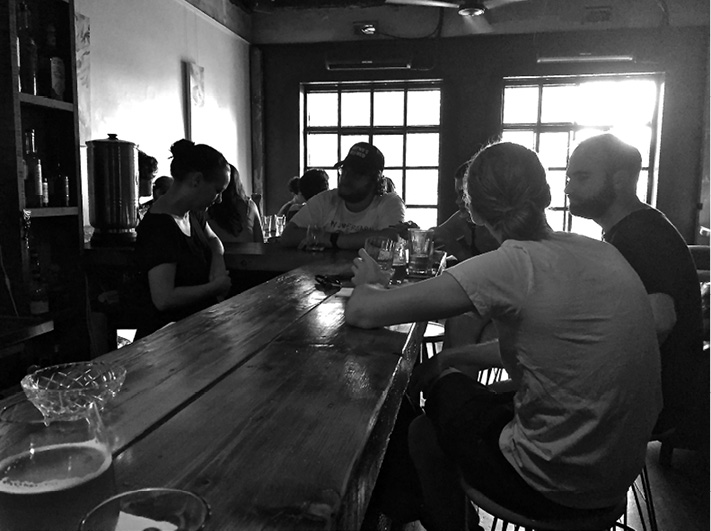
Bitter Phew is one of the more popular beer hangouts in Sydney, Australia.
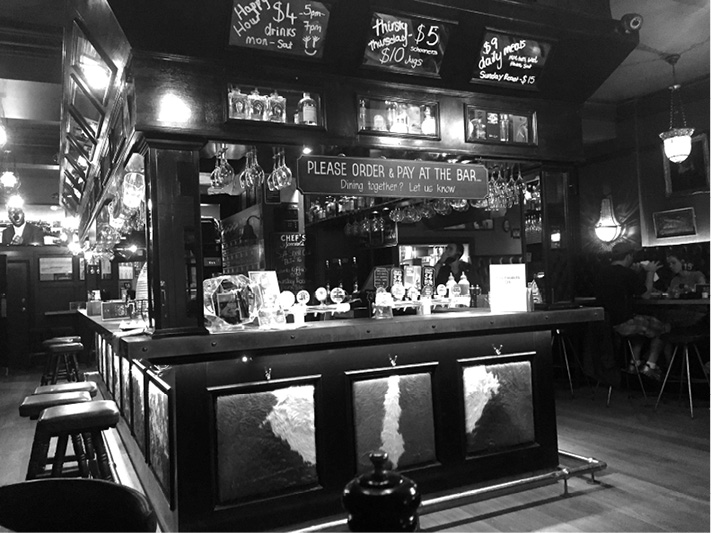
Sydney’s K&B.
Auckland, New Zealand
Kiwis have been riding the same artisanal wave that the Aussies have been enjoying, and the bar scene is all the better for it. And some of the best places to drink are popping up in some of the most unlikely of places. Case in point: No. 1 Queen in Auckland’s central business district. At first glance, it appears to be nothing more than a coffee kiosk a stone’s throw from the city’s main mass transit hub—a place one would expect to grab a pre- or post-commute cup of joe and perhaps a doughnut. But on closer inspection, it reveals itself to be a full-on beer bar with some seating inside its walls but with more on picnic tables outside. In 2012 the spot made the wise business decision to become a showcase for the best brews the North and South Islands of New Zealand have to offer. The spot, named for its address, also hosts a weekly craft beer market each Wednesday, when twenty or so brewery reps hawk their wares to the public. It’s also reserved a full cooler for folks to share their homebrews.
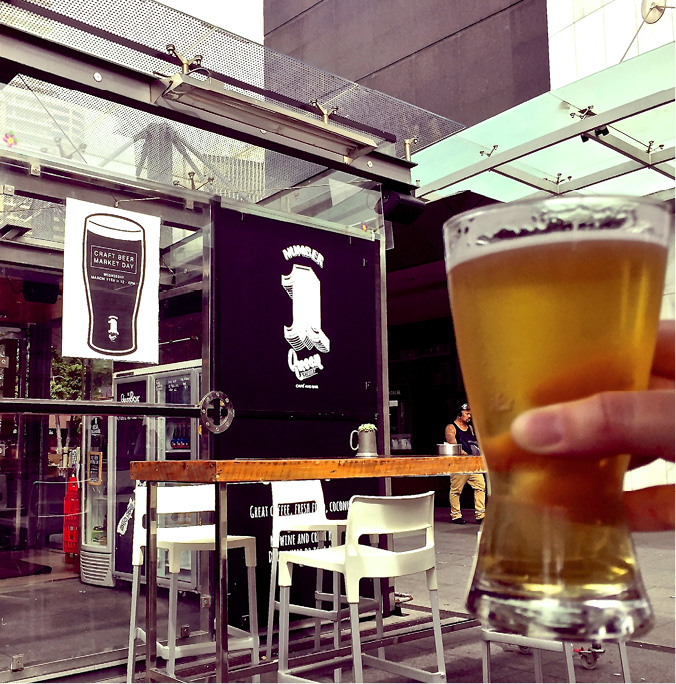
Auckland, New Zealand’s No. 1 Queen craft beer café.
Hong Kong
Hong Kong is a bit late to the party with the whole craft beer thing, but things are changing very quickly there. Since 2012 the city has hosted an enormously successful beer festival, and the local brewery activity has increased more than five-fold. The most vivid symbol of its burgeoning craft brew scene is a little pub called the Roundhouse Taproom in the Central district neighborhood of SoHo. Twenty-five taps as well as a generous selection of bottles await visitors. Everything from up-and-coming Hong Kong brewers like Young Master and Moonzen to international favorites like Evil Twin, Brooklyn Brewery, and Founders are well represented at this industrial-chic hideaway. It’s definitely taken a cue from the United States; even its barbecue-centric food menu has an American bent. When it comes to beer, Hong Kong is on the cusp of greatness, and the place to witness the revolution—which, by the way, will not be televised—is the Roundhouse.
For a classic English pub feel (the Brits controlled Hong Kong until 1997, after all), there’s the Globe, a stone’s throw from the Roundhouse. And though it may have been founded by a British expat (Toby Cooper, who also happens to head the Hong Kong Craft Beer Association) and sport aesthetics and food menu of a UK local—it does have some real ale on cask—its beer list is beyond modern. One could even argue that it was ahead of its time for the city, offering the best of the best from the world’s greatest craft brewers and showcasing the local upstarts that are redefining Hong Kong brewing.
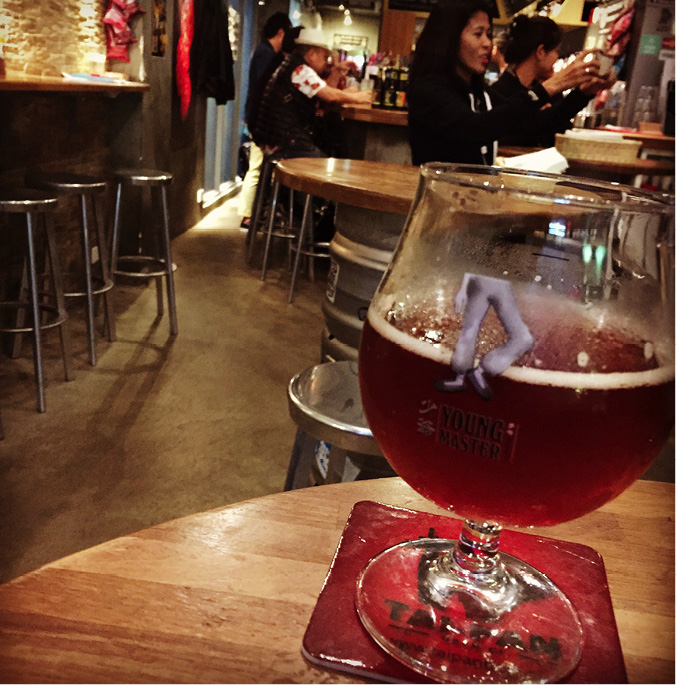
Hong Kong’s Roundhouse Taproom.